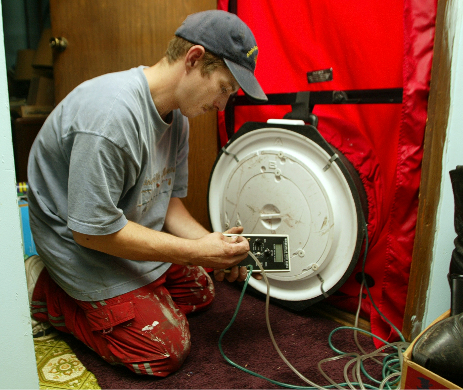Clean Energy Works Portland is a groundbreaking new program that enables Portland residents to improve the energy efficiency of their homes and pay for the improvements over time through their utility bills.
 A contractor performing a blower door test to identify air infiltration and leakage throughout a home.Energy Trust of OregonBut the most exciting and unique aspect of the program is the Community Workforce Agreement that was developed by representatives of labor unions, community groups, businesses, community colleges, and other stakeholders. It is a comprehensive plan to make sure that new jobs created by Clean Energy Works Portland are high quality, career-track jobs that offer family-supporting wages and benefits, and that they go to local residents from diverse backgrounds.
A contractor performing a blower door test to identify air infiltration and leakage throughout a home.Energy Trust of OregonBut the most exciting and unique aspect of the program is the Community Workforce Agreement that was developed by representatives of labor unions, community groups, businesses, community colleges, and other stakeholders. It is a comprehensive plan to make sure that new jobs created by Clean Energy Works Portland are high quality, career-track jobs that offer family-supporting wages and benefits, and that they go to local residents from diverse backgrounds.
“We wanted to have this project reflect some higher set of goals beyond just retrofitting homes and reducing carbon emissions,” said Derek Smith of Portland’s Bureau of Planning and Sustainability, the city’s go-to person on the Clean Energy Works Portland program.
The program uses $2.5 million in Energy Efficiency and Conservation Block Grant funds the city received through the American Recovery and Reinvestment Act as seed money to start a revolving loan fund that will enable Portland homeowners to improve the energy efficiency of their homes at no up-front cost. The energy improvements that will be available to homeowners during the pilot phase of the program, which will cover 500 homes, include insulation, air sealing, duct sealing, and improvements to space heating and water heating systems.
The Energy Trust of Oregon will schedule home energy assessments for interested homeowners and help them choose the energy saving options that best meet their needs. To pay for the improvements, homeowners will receive low-interest, long-term loans and will pay them off via their monthly utility bills.
Once the pilot phase is completed next summer, some 100,000 homes in Multnomah County, which encompasses the city of Portland, could qualify for the program.
A state law, Oregon’s Energy Efficiency and Sustainable Technology Act of 2009 (HB 2626), made the Portland financing mechanism possible. “Portland is the first pilot project for this new statewide, low-interest loan program for weatherization work that you can pay back on your utility bill. That’s how we’re going to spread this idea around the state,” said Barbara Byrd, who wears many hats in Oregon, including secretary-treasurer of the Oregon AFL-CIO and coordinator of the Oregon Apollo Alliance, which strongly supported passage of HB 2626.
Fifty-five direct jobs will be created by the pilot program, but many more are expected to be created after the pilot phase. In order to make sure those jobs will have good wages and benefits and be accessible to community members with previous barriers to employment, the city pulled together approximately 60 stakeholders to develop a Community Workforce Agreement that would complement Clean Energy Works.
Smith of the Portland Bureau of Planning and Sustainability said he got the idea to bring labor and training standards and community benefits into the program from being part of the Green For All “community of practice.” The community of practice connects people throughout the United States who are working on green jobs programs and helps them share their learning experiences with others in the field. Green For All is a partner in Clean Energy Works Portland, along with the Energy Trust of Oregon, Portland General Electric and others.
Maurice Rahming, president of the National Association of Minority Contractors of Oregon, participated in the Clean Energy Works Portland stakeholder meetings that culminated in the Community Workforce Agreement. “I think it’s a tribute to the mayor that he got minority contractors involved early on, rather than having them involved at the very tail end. It shows he’s looking to diversify the contracting pool,” Rahming said.
“Construction isn’t always the most diverse workforce that’s out there, and we wanted to set up an understanding that let’s have the workforce and the contractors reflect the city of Portland,” he added.
In addition to minority contractors, the stakeholder meetings included many groups that offer pre-apprenticeship training to prepare people in basic work skills so that they can then enter training programs that teach skills specific to an occupation. These groups included the Native American Youth and Family Center, which offers employment training courses to Native Americans; and Oregon Tradeswomen, which offers women training courses to prepare them to enter the building and construction trades. Pre-apprenticeship training programs like these will funnel participants into weatherization technician training courses linked to Clean Energy Works Portland.
Many labor unions also participated in the development of the Community Workforce Agreement, including the Laborers union, which is about to begin offering training courses in weatherization that will be available to graduates of the pre-apprenticeship programs described above. “A part of what we wanted to see [in the Community Workforce Agreement] was that people were going to get quality training, because then they’re going to come into the market with better skills, and that’s a chance for them to get their wages up,” said Al Davita, the training director of the Laborers Training Program in Oregon and southern Idaho.
Davita said the Laborers will be providing three levels of training in weatherization-an 80-hour entry-level class for weatherization installers/technicians that will require 80 hours in general residential construction to get into the class; a 40-hour weatherization supervisor training; and a 40-hour energy auditor training. This means that trainees who become weatherization technicians through Clean Energy Works Portland will be able to move into other careers with additional training.
“Our plan is to recruit people who are out of work, give them quality training so they can go out and do this work, but also give them a career pathway so that they can potentially stay in weatherization for the next 20 years or may be able to move into commercial building construction or demolition, where the wages are higher. So we’re looking to give people the chance to change their lives,” Davita said.
After five weeks of meetings, the stakeholders came to consensus on a Community Workforce Agreement for the Clean Energy Works Portland pilot program that lays out requirements for worker training, wages and benefits, local hiring, contractor standards and more. Key goals and targets of the agreement, which was passed by the Portland City Council on September 30, include:
Local hire: at least 80 percent of employees used in the pilot program will be hired from the local workforce.
Family-supporting jobs: workers will earn no less than 180 percent of the state minimum wage.
Diverse workforce: historically disadvantaged or underrepresented people, including people of color, women, and low-income city residents, will perform at least 30 percent of total trades and technical project hours.
Diverse business participation: twenty percent of the dollars that flow through the project will go to businesses owned by historically disadvantaged or underrepresented people.
Prevailing wage: contractors will pay wages that are at least 180 percent of Oregon state minimum wage or the prevailing wage for weatherization work, whichever is higher.
Worker training: contractors will hire 100 percent of new weatherization employees from designated training programs until 50 percent of the contractor’s non-supervisory work hours are performed by these training program graduates.
Labor peace: contractors will sign a labor peace agreement that includes a majority sign-up provision (meaning that contractors will respect the will of the workers if a majority of them signs up to form a labor union).
The Community Workforce Agreement also sets up a system of “best value contracting,” which means that contractors wishing to join the pool of qualified contractors for the Clean Energy Works Portland program will be scored on a range of attributes. They will earn points for having a successful track record of hiring and retaining historically disadvantaged people; having a plan for establishing sub-contracting relationships with businesses owned by people of color and women; and hiring graduates of pre-apprenticeship training programs, among other criteria.
Clean Energy Works Portland’s criteria for qualified training programs requires the programs to have at least three defined partnerships with state recognized pre-apprenticeship programs or signatory community organizations that service underrepresented populations, and to make sure a majority of trainees are women, people of color, low-income people or people from disadvantaged communities.
“In Oregon, a state with one of the highest unemployment rates in the country, Clean Energy Works Portland stands to provide a scalable national model by leveraging federal recovery dollars to put people back to work and achieve significant carbon reductions,” said Portland Mayor Sam Adams. “With our community workforce agreement, we have the ability to promote social equity in a measurable way, providing an opportunity for under-employed youth and adults to gain career training in the sustainable building industry, and ensure that Portland stays at the forefront of the green economy.”
For other cities that are considering designing programs similar to Portland’s, several of the people who participated in the process that created the Community Workforce Agreement emphasized the importance of involving stakeholders early in the process. “My bottom line advice is that if you want to do this, you have to involve the stakeholders from the very beginning of the process,” said Barbara Byrd. “It’s not something the city can put together and ask people to sign on to. It was the involvement of the stakeholders that not only created the workforce agreement, but will also make sure it works.”
Rahming said that the early involvement of minority contractors will help them be able to participate in the program. “In contracting, time is everything,” Rahming said. “A lot of times, larger companies can put proposals together more quickly, because they have more staff. This time, because the project was presented to my contractors at the front end, it will allow them to be able to meet the wage and benefits and training requirements.”
Now that the Community Workforce Agreement is in place and the pilot program has already begun converting loans for homeowners, some of the same people who were involved in the stakeholder process will oversee how the program is run.
“The side benefit of this whole effort is energizing a community,” Smith told Oregon Live in a recent interview. “People are really interested in this. It’s good for the economy. It’s good for their home energy bills and (the environment). It seems like one of the promises of the new clean economy could be realized here.”
For more information about Clean Energy Works Portland, go to www.cleanenergyworksportland.org.
Read the Community Workforce Agreement.



